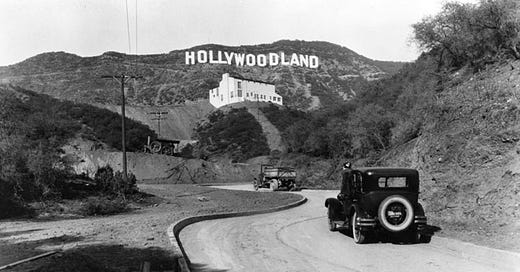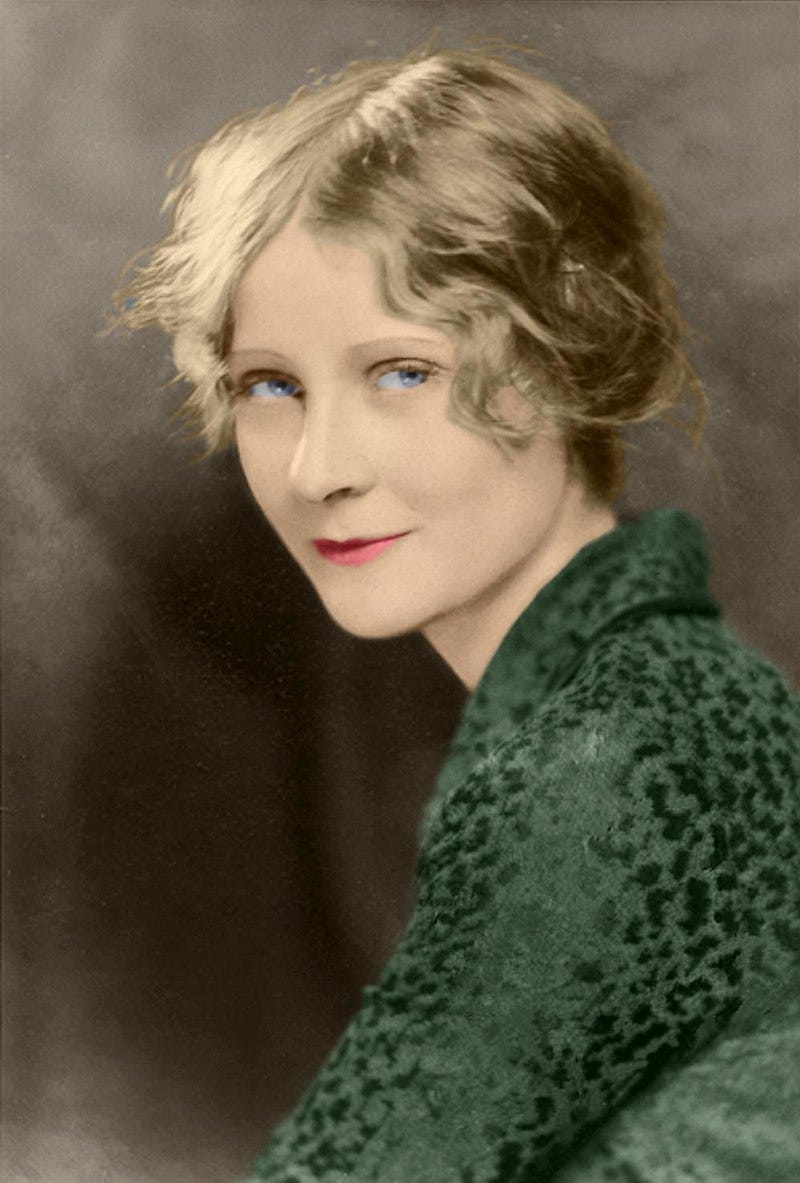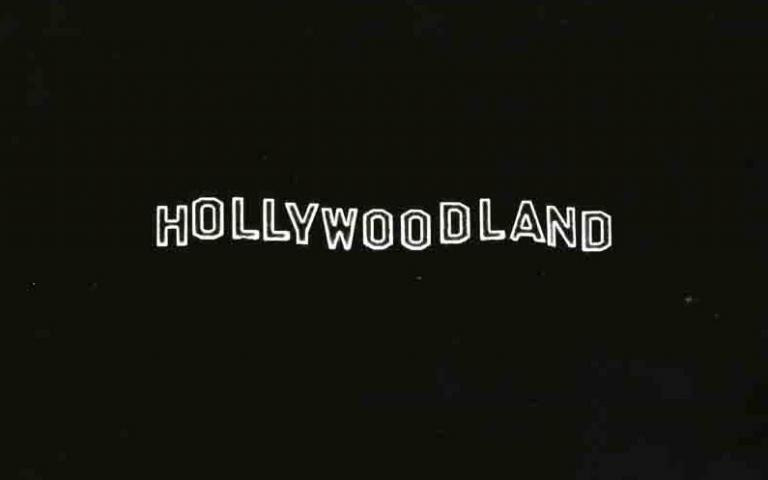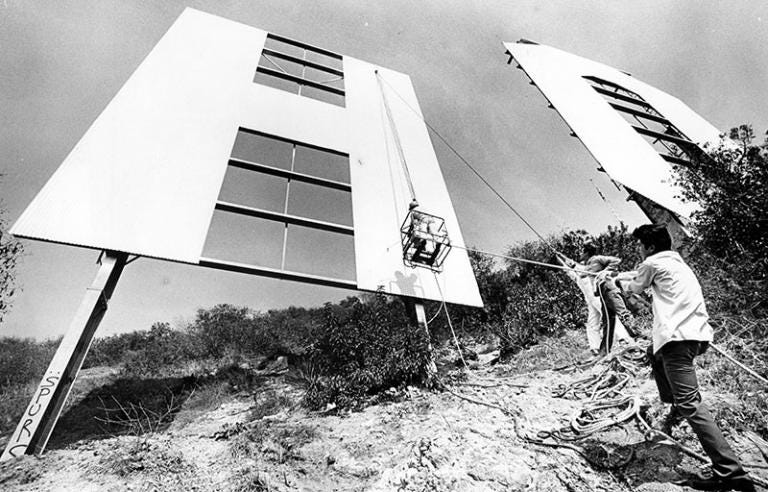Lana and Peg in Hollywoodland
Peg Entwistle committed suicide from the H of the Hollywood sign. LDR's "Lust For Life" unwittingly connects itself.
The title track of Lana Del Rey’s Lust For Life paints an eerie picture, one of Lana dancing until death atop the H of the Hollywood sign, that old real estate advertisement, now a ubiquitous shining signifier of an entire industry and culture — and the dark disillusionment that clings to it like shadow. But Lust For Life is not a haunting album—it’s a haunted one, made equally vibrant from appearances by both the living, and the dead.
Eighty-four years before Lana appeared atop that sign, however, a young actress did her own macabre dance on the famed sign and dove fifty feet below gruesomely ending her life. Her name was Peg Entwistle. She was 24-years-old. She was loved.
Born Millicent Lilian, performance quickly caught her eye. When she was twelve years old, Millicent saw Laurette Taylor in Peg O’ My Heart at the Cort Theater, Valentine’s Day 1921, and decided to adopt the titular character’s name. She’d then climb the ranks of Broadway, talented and well-liked, as Peg Entwistle. But she’d only hold the moniker for about a decade.
After beginning a successful stage career, Peg ventured west toward the Golden Age of Hollywood. She broke a theater contract for the screen, signing with Radio Pictures, or simply RKO as it was soon to be known, a nearly traitorous move for some in the stage scene. Heck, the talkies only began a couple years ago — wasn’t this just some pan-flash out in the Wild West? When RKO rather quickly dropped her from the contract, Peg felt foolish, and now cut off from both sides of the acting coin. Would they want her in New York? Did she have a place in Los Angeles? How small that must have made her feel. How hopeless.
Peg had also just exited a wildly toxic relationship, one that started all champagne and blush. Robert Keith was an established stage actor as well, and the two fell for each other like a gold rush. Their first date was to see Fritz Lang’s Metropolis, and within a week they were wed. But Robert’s dark showed itself quickly, he hadn’t told her he’d been married before, with a six-year-old boy to show for it. His name was David and he’d later play Uncle Bill on Family Affair. Like Peg, he too would commit suicide. He shot himself in the head, ten weeks after his daughter Daisy did the same.
Along with this undisclosed marriage, Robert owed alimony that he was too broke and drunk to pay. Peg footed the bill and continued to support him financially while he emotionally abused her. She had to prove in court his alcoholic aggressions were adversely affecting her career. She did, and secured a divorce. All that came after paying what would equate to roughly $2,000 today for an illegal abortion.
Following this traumatic relationship, Peg watched her ex husband meet a woman named Dorothy and fall truly in love, clean up his act, and climb the ladder of success. It was undoubtedly an agonizing pain for her, watching her abuser happy with love, advancing his career, after taking care of him with nothing to show for it but a drained bank account and a suffering professional reputation. How hopeless she must have felt. How small.
Upon the single’s release, Genius wrote an article about the Peg Entwistle connection, and surprisingly, Lana replied she’d never heard that story before. I’m not entirely convinced that’s the whole truth, but it makes for a good ghost story: Gorgeous, modern ingénue, brilliant and troubled, works on richly dark album in the Hollywood Hills, penning a song about dancing till death on the Hollywood H, unbeknownst to her that the actress’ apparition still hikes Mount Lee.
– we've never heard that story down here at the studio. pretty Erie. And I've never seen a ghost in my apartment inside the H.
— Lana Del Rey (@LanaDelRey) April 22, 2017
To this day locals claim to see Peg still. Or some echo of the tragic, sensationalized Peg: a ghostly figure, blonde and fair, clothed in 1930s fashions, determinedly walking up that hill, often in the hugging fog or the maddening winds of fall. Del Rey’s beautifully fatalistic yet simultaneously optimistic album is chock full of ghosts like this. She invokes the Victorian poet William Ernest Henley, his darkly positive poem Invictus, she references Sinatra, of course, and Charles Manson, whose dark California devilry occurred in two sets of hills bookending Peg’s, in the hellish swelter of summer.
She winks at the famous pop song “My Boyfriend’s Back,” fittingly sung by three attractive young women who went by The Angels, of course. They began as The Starlets. One was named Peggy. The rest of her album also echoes bands long dead, if not their actual members, with sonic and lyrical callbacks to The Beach Boys, Neil Young, Led Zeppelin, and a long-gone version of Bob Dylan. Stevie Nicks, the queen of witchy wonder, duets with Lana, a collaboration that, retrospectively feels so obvious yet still comes off as magical. Even Sean Lennon’s vibrant appearance can’t shake the cobwebs of haunt, his delicate voice forever some morbid echo of his father’s own.
Even if it was unwitting, Peg lives on, in this album, too, regardless if Lana cast her purposefully in the role. Long after her fatal flight, she’s here, haunting the record of another beautiful starlet. It’s a nice cinematic yarn, and a more eerily enjoyable tale than that of Peg’s end.
Peg told her aunt and uncle she was off to buy a book from the local drugstore, then meet some friends. She lied. She walked north on Beachwood Drive to the glowing sign. At the time it still read “Hollywoodland,” the name of the housing development that the letters were originally erected to advertise. It would have taken her about forty minutes. It was a Friday night in September. The weather, once advertised as “clean, pure mountain air” was probably dry and hot, with wicked Santa Anas blowing the brush, fluttering her dress and whipping her hair.
She climbed a maintenance ladder behind the first letter of the sign, and leapt. She fell fifty feet. She landed horizontally and likely didn’t die upon impact. Her entire pelvis shattered. The speed of the fall and the angle of the slope flung her broken body from its surface 100 feet farther. She tumbled, in agonizing pain, hopefully unconscious, into a small ravine. The pile of gravel that was once her pelvis flooded with internal bleeding until the oxygen left her brain and her heart ceased beating. The horrific crash of bone and branch now quiet, the sizzling hum of 4,000 light bulbs blistered on and off in 4/4 time: Holly. Wood. Land. Hollywoodland.
Her body wouldn’t be discovered for two days.
It’s interesting that the track to follow “Lust for Life” is called “13 Beaches.” The only film role Peg ever booked was for industry titan David O. Selznick during her stint at RKO. The film was called 13 Women. Its plot concerned a young woman of mixed ethnicity who was ruthlessly bullied by thirteen of her sorority sisters. The girl spends her post-collegiate years studying the occult and hypnotism, then uses her witchy skills and fabricated horoscopes to push her abusers toward insanity, to murder their loved ones, to even commit suicide.
Lana would love it.
Although she claims the song is about escaping the paparazzi, many of the lyrics could be interpreted as rumination on suicide, or at the very least choosing death — buried beneath pines and pushing up daisies, crossing the “county line” that separates the here and the ever-after, maybe in a white Mustang.
Cruelly enough, thanks to the burgeoning Hays Code, Peg’s lesbian storyline in 13 Women was severely truncated. When the film premiered, shortly after her death, she’d nearly been erased, a ghost once more in discarded celluloid. If she can’t live on in the visual medium though, Peg’s ghost will haunt in other senses. Her favorite perfume was that of gardenia blossoms, and when reports of her spirit stalking the canyon spill in, they say the scent blankets the hillside.
Like that scent, and like the sinister Santa Anas pouring down from the Great Basin at summer’s wilt, the dark fabric of depression that blankets us all is ever-present in the sound and lyrical content of Lust For Life. It makes sense; it seems everywhere because… it is everywhere: depression, anxiety, trauma, suicide, a growing and gargantuan national fear. Lana isn’t sad for sad’s sake — she’s tuned the fuck in. She’s a stardust, spell-casting empath, touching the depressed wavelengths of the youth, somehow even making romantic and serious the bloated, branded, buy-fest that is Coachella. She wrote a song about that mammoth festival in fear of a North Korean missile strike, for Christ’s sake.
She tells us she’d climb that stairway to Heaven just to ask God what the damn point of all this is and if we’ll all be okay. A few songs later she wonders if this is the end of our country. Haven’t we all? The filling of today’s American pie is shadow and hurt, and everyone feels it — even the primarily privileged youth dancing in Indio, blissed out and crowned in flower.
Much is often made about Del Rey’s attraction to early demise, a focus on fatality. Sure, it’s signature to her style, and there’s no lack of it on Lust For Life. A fair amount of the recordings feel like they could’ve been conjured on Jan and Dean’s doomed drag route. Lana romanticizes heroin, she refers to firing squads, she discusses escaping demons, and mentions more than a few coded references to the afterlife.
But Lana doesn’t want to die. That’s the entire point. Her sound, and likewise her content, aren’t black like the beaches she sings of, they’re a green so dark they seem to be some emerald onyx, with flora aching to sprout from every pitch-dripping abyss. She has a lust for life, remember? A lust for all that blooms once the dull roar of living is placed on mute.
She doesn’t have a death wish; she has an escape wish, to leave behind the grim grip of modernity. If she dances long enough up on that Hollywood sign, maybe she can forget the sad, congested boulevards below. And if she falls from that H, if she buys that stairway to heaven, maybe she’ll live forever, like the undead on her album, and plunge deep into a forgotten time: A golden-hour, silver screen, nation of nostalgia, where no one truly dies, and the glamorous keep on glowing.
Maybe she’ll see Peg there, in a beautiful blue dress, the smell of gardenia blossoms in the hazy ballroom of their minds, almost as large as the Hollywood sign.








perfect read this morning. as always, thanks alan ♥️
💯